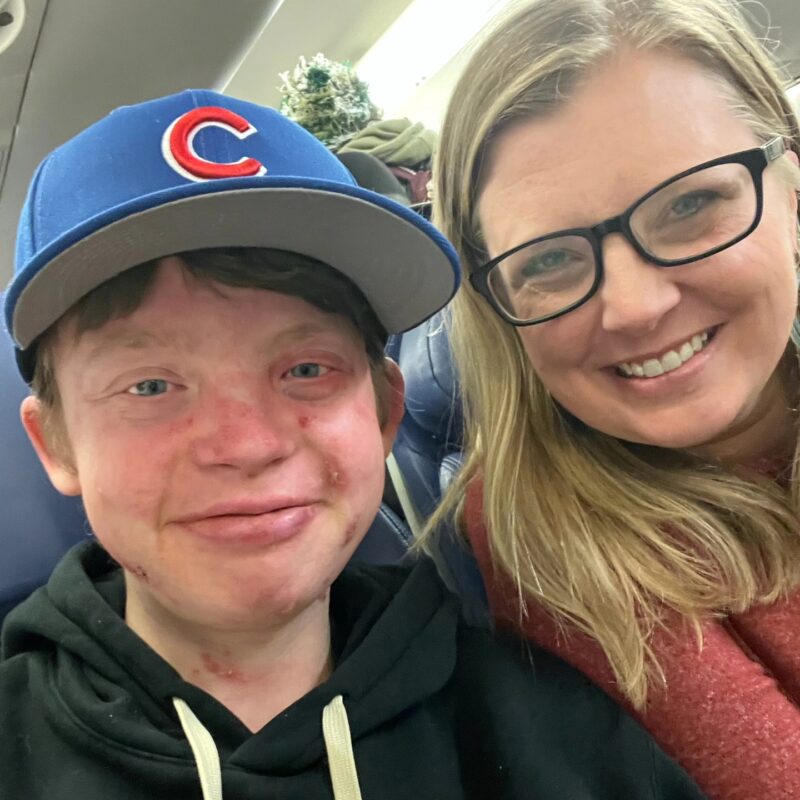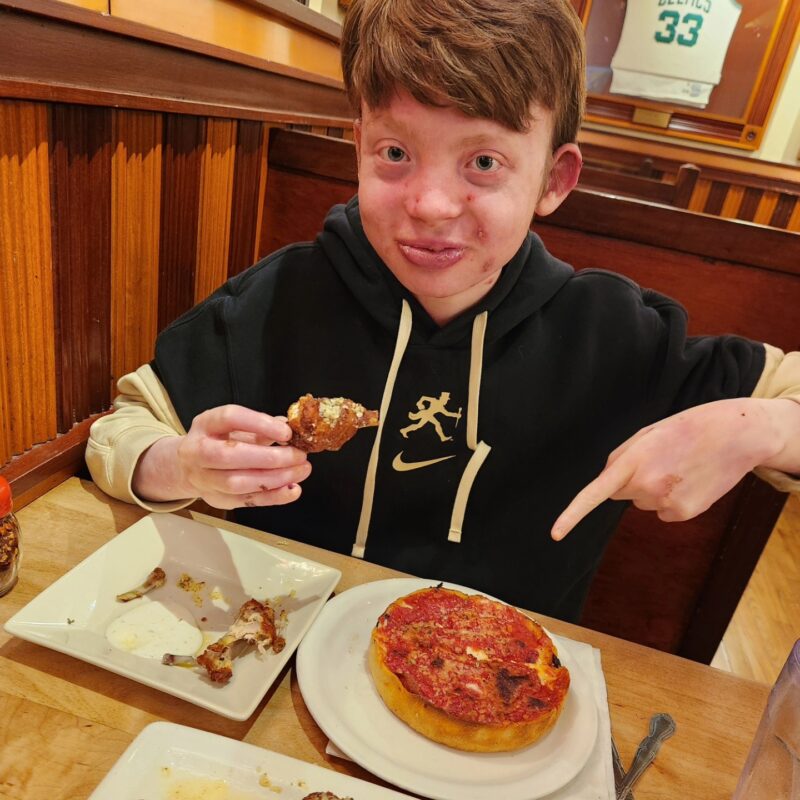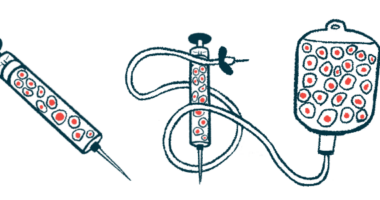My son’s skin has greatly improved during a dupilumab clinical trial
The medication is being studied as a potential treatment for EB

Note: This column describes the experiences of the author’s son with dupilumab. Not everyone will have the same response to treatment. Consult your doctor before starting or stopping a therapy.
Jonah, my son with epidermolysis bullosa (EB), and I just made another trip to Chicago right before Christmas. This time there was no riverboat cruise, no Cubs game, and no time spent at the Bean. However, we did absolutely make time to grab some pizza at Lou Malnati’s, where the pizza was good, but the garlic parmesan wings were the best we’ve ever had.

Jonah and Patrice head to Chicago in December 2024 for his week 16 appointment, part of a dupilumab clinical trial. (Photo by Patrice Williams)
I have to say we prefer Chicago’s early September weather over its late December weather. We were underdressed. Jonah didn’t own a real coat at the time because he’s a North Carolina teenager — meaning you wear a hoodie every day, and coats are stupid (like I already told you, Mom). Even the walk around the block to the nearby Nike store was too much, with blustery wind and wet snow smacking us in the face.
Magical Christmas lights or no, the weather was unpleasant. I happen to be highly motivated by food, though, so what I’m saying is that the wings were worth it.
We flew up on Dec. 19 and back on the 20th, a whirlwind trip for Jonah’s week 16 dupilumab checkup appointment. As I shared in September, Jonah is participating in a clinical trial at Northwestern University that’s investigating the possible benefits of dupilumab for patients with EB. The medication, also known by its brand name Dupixent, has been approved by the U.S. Food and Drug Administration to treat eczema, and researchers are studying its effects on children with other skin disorders.
Jonah participated in eight weeks of data gathering, wearing an itch sensor at night and filling out both daily and weekly surveys. At week zero, we traveled to Chicago for a full checkup, blood work, and his first two injections of the medication. Over the next 16 weeks, his nurse gave him an injection of the medication once every two weeks.
(Side note: Thank God for Nurse Clair because I can do wound care all day, but giving injections isn’t my strong suit. Needles are scary, and Jonah has been much braver about this whole thing than I’ve been.)

Jonah enjoys pizza and wings at Lou Malnati’s during his most recent trip to Chicago. (Photo by Patrice Williams)
Throughout those 16 weeks, Jonah and I both continued to fill out surveys, he wore the itch sensor at night, and we submitted photos of the progress of his skin.
His results have been incredible.
A marked improvement
Although this medication is definitely not a cure — Jonah’s skin is still fragile, and he continues to develop blisters daily — he is incredibly improved. He has so few blisters on his arms that during the day, he’s completely unbandaged there for the first time in his life. You should have heard him squeal the first time he stuck his unbandaged arm into the refrigerator to pull out food. His hypersensitive arms had never felt that chill before!
His face is clearer. His legs remain bandaged and blister worse than his arms, but they’re still greatly improved. The skin that isn’t blistered used to be red, flaky, and angry. This irritation caused him pain, increased the fragility of his skin, and made him scratch, causing even more blisters. There’s no angry skin on his body now. The intact skin between blisters is smooth, clear, and his normal color.
It may be completely unrelated to the medication, but the one corneal abrasion he’s had since starting the medication was so mild, it healed within a matter of hours. Maybe it was just luck, but I’m hoping the medication is working from the inside out and helping with more than just his level of itchiness. It certainly seems to be reducing his overall inflammation and irritation.
Jonah’s results may not be what others in the trial are experiencing. But for us, dupilumab seems to be working. Although it’s not a cure, and the effects are likely to plateau, his skin is much healthier overall, he’s wearing fewer bandages, and his bandage change times are shorter. He’s experiencing less itch and, more often than not, less pain.
Most of all, those arms are now free to feel that cool fridge air!
Note: Epidermolysis Bullosa News is strictly a news and information website about the disease. It does not provide medical advice, diagnosis, or treatment. This content is not intended to be a substitute for professional medical advice, diagnosis, or treatment. Always seek the advice of your physician or other qualified health provider with any questions you may have regarding a medical condition. Never disregard professional medical advice or delay in seeking it because of something you have read on this website. The opinions expressed in this column are not those of Epidermolysis Bullosa News or its parent company, Bionews, and are intended to spark discussion about issues pertaining to epidermolysis bullosa.








Aimee Visserman
This is such an answer to prayer! Grateful for this for you and Jonah! Miss you all<3
Wanda Wilkinson
Awesome. I had noticed his face was much clearer. I miss our conversations. Love all of you